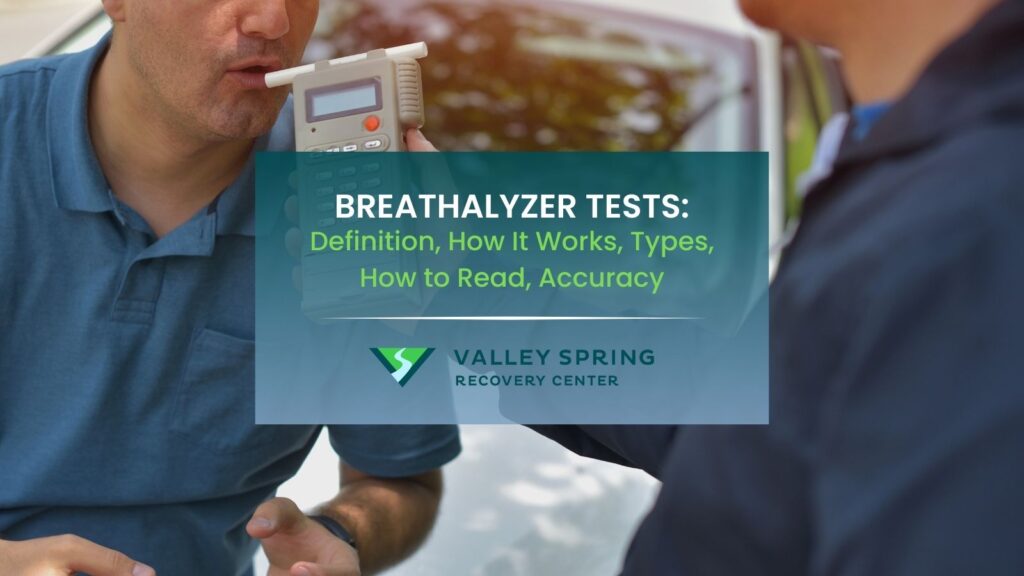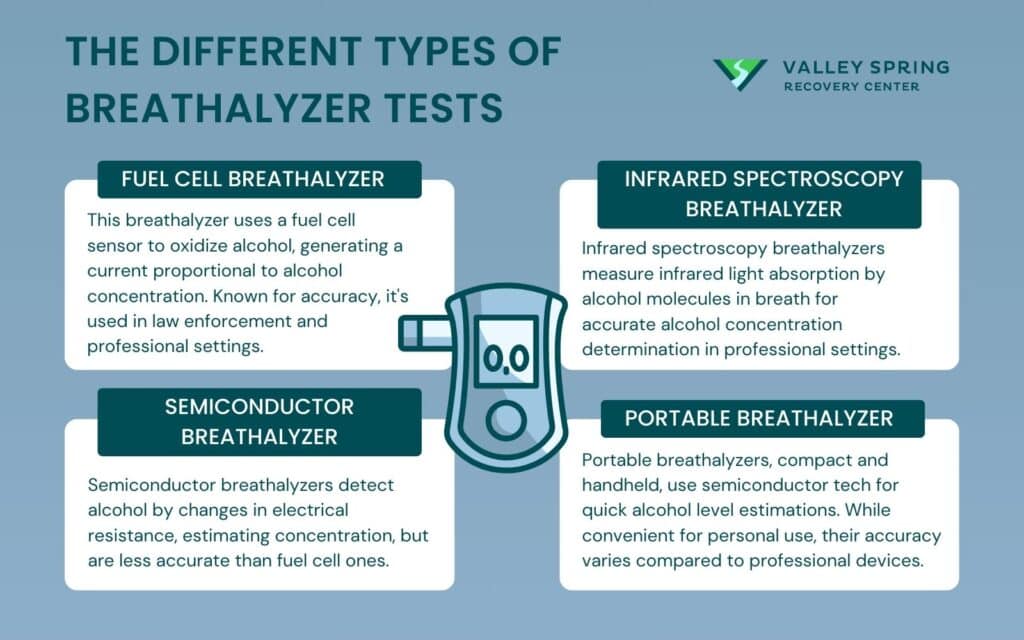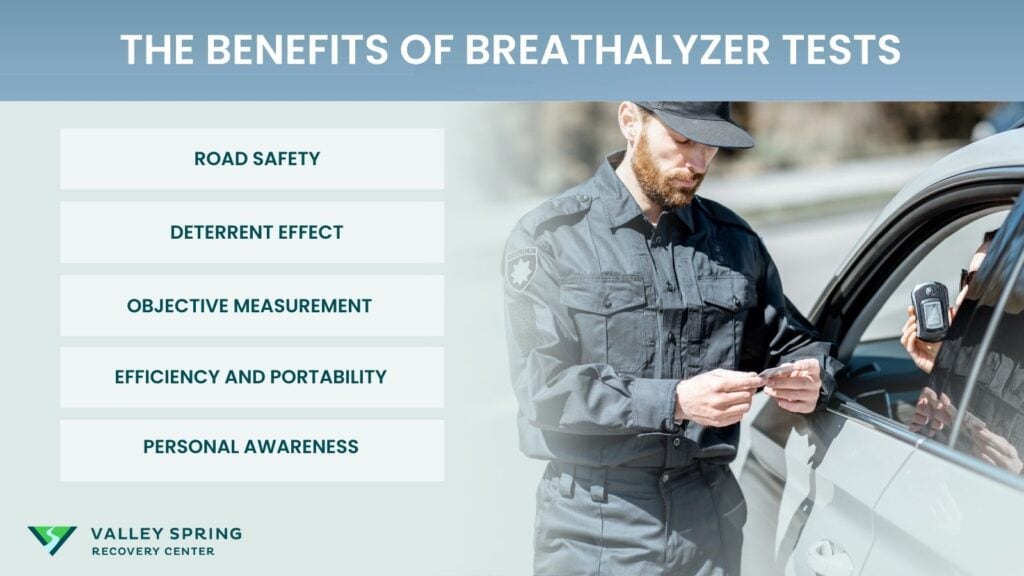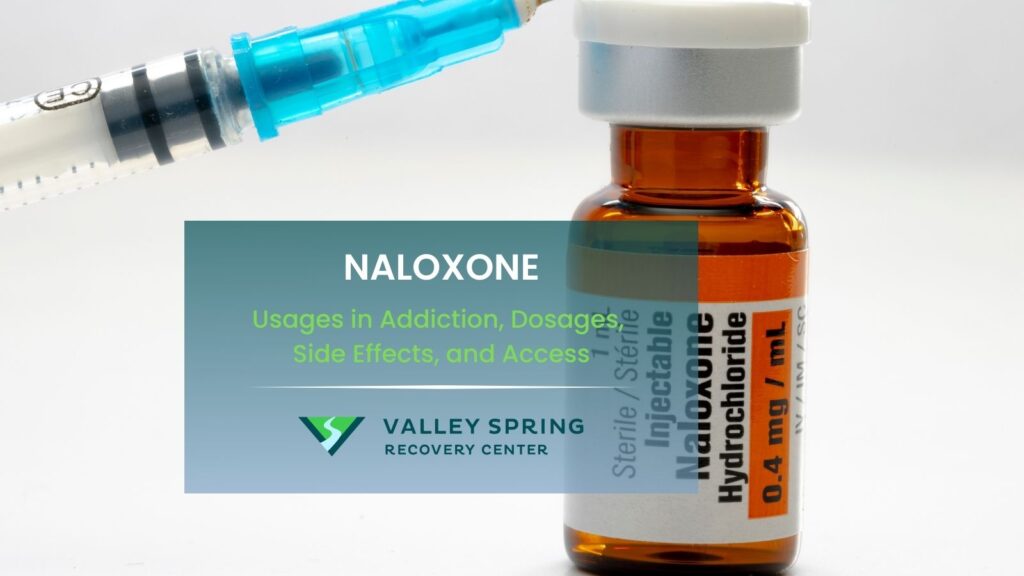Breathalyzer Tests: Definition, How It Works, Types, How to Read, and Accuracy

Breathalyzer tests are a method of estimating Blood Alcohol Concentration (BAC) by measuring the alcohol content in a person’s breath. They are used to assess alcohol impairment, particularly in situations such as law enforcement, traffic safety, and personal monitoring.
There are four types of breathalyzer tests: fuel cell, semiconductor, infrared spectroscopy, and portable breathalyzers, each utilizing different technologies for measuring alcohol concentration.
Breathalyzers are read by examining the numerical reading on the device, which represents the estimated Blood Alcohol Concentration (BAC) level based on the alcohol content detected in the breath sample.
The accuracy of breathalyzers vary depending on device calibration, proper usage, and the presence of interfering substances, but modern breathalyzers used in controlled settings are considered to provide reliable estimations of Blood Alcohol Concentration (BAC).
What is a Breathalyzer Test?
A breathalyzer test is a device used to measure the amount of alcohol in a person’s breath. It is used by law enforcement officers to determine if someone has been drinking and to estimate their blood alcohol concentration (BAC).
BAC stands for Blood Alcohol Concentration, which is a measure of the amount of alcohol present in a person’s bloodstream. It is typically expressed as a percentage and is used to assess the level of alcohol intoxication or impairment.
The breathalyzer test was invented by Robert Frank Borkenstein, a former captain with the Indiana State Police, in 1954. The first practical use of the breathalyzer test was in the field of law enforcement for testing drivers suspected of drunk driving.
The breathalyzer test gained widespread adoption and recognition for its accuracy and reliability in measuring alcohol levels. It has since become a standard tool used by law enforcement agencies around the world for assessing impairment due to alcohol consumption.
Did you know most health insurance plans cover substance use disorder treatment? Check your coverage online now.
How Does a Breathalyzer Test Work?
Here is a detailed explanation of how a breathalyzer test typically works:
- Breath Sample Collection: The person being tested blows into the breathalyzer device through a mouthpiece or a tube. The breath sample must be deep enough to ensure adequate air from the lungs is captured.
- Chemical Reaction: Inside the breathalyzer, the breath sample comes into contact with a sensor or a chemical reaction chamber. The most common technology used is the fuel cell technology or infrared spectroscopy.
- Fuel Cell Technology: In fuel cell technology, the breath sample enters a chamber containing a platinum electrode, which acts as a catalyst. The alcohol in the breath oxidizes on the electrode, producing an electrical current proportional to the amount of alcohol present.
- Measurement of Electrical Current: The electrical current generated by the oxidation reaction is measured by the breathalyzer. This current is then converted into a digital reading that represents the estimated Blood Alcohol Concentration (BAC).
- Calibration and Accuracy: Breathalyzer devices require regular calibration to ensure accurate readings. Calibration involves testing the device with a known alcohol concentration to verify its accuracy and make necessary adjustments if required.
- Conversion to BAC: The breathalyzer reading is typically displayed as a BAC percentage, representing the amount of alcohol in the bloodstream. This reading is used as an estimate of the person’s level of alcohol intoxication or impairment.
Breathalyzer tests are used as a preliminary screening tool, and more precise measurements are obtained through blood tests if legal or medical accuracy is required.
What are the Different Types of Breathalyzer Tests?

There are 4 types of breathalyzer tests available, and they include:
1. Fuel Cell Breathalyzer
This type of breathalyzer uses a fuel cell sensor that oxidizes alcohol in the breath, producing an electrical current proportional to the alcohol concentration. It is known for its accuracy and is used in law enforcement and professional settings.
Contact us today to schedule an initial assessment or to learn more about our services. Whether you are seeking intensive outpatient care or simply need guidance on your drug addiction journey, we are here to help.
2. Semiconductor Breathalyzer
Semiconductor breathalyzers use a semiconductor oxide sensor to detect alcohol. When alcohol molecules come into contact with the sensor, the electrical resistance changes, allowing the device to estimate the alcohol concentration. Semiconductor breathalyzers are less expensive but have lower accuracy compared to fuel cell devices.
3. Infrared Spectroscopy Breathalyzer
Infrared spectroscopy breathalyzers work by measuring the absorption of infrared light by alcohol molecules in the breath. The device emits an infrared beam through the breath sample, and the amount of light absorbed is used to determine the alcohol concentration. Infrared spectroscopy breathalyzers are known for their accuracy and are used in professional settings.
4. Portable Breathalyzer
Portable breathalyzers are compact, handheld devices designed for personal use. They often use semiconductor technology and provide a quick estimation of alcohol levels. While portable breathalyzers are more convenient for personal monitoring, their accuracy vary compared to professional-grade devices.
Understand that different breathalyzer devices may have varying levels of accuracy and reliability.
Rediscover Life at Valley Spring Recovery Center
Get the compassionate support you deserve. We're here to help you reclaim joy, wellness, and a brighter future.
Verify Benefits
How is a Breathalyzer Test Read?
A breathalyzer test is read by examining the numerical reading displayed on the device, which represents the estimated Blood Alcohol Concentration (BAC) based on the alcohol content detected in the breath sample. The BAC reading is presented as a percentage or as a numerical value.
When interpreting the breathalyzer test result, it’s important to consider the legal guidelines and regulations specific to the jurisdiction in which the test is being conducted. The legal limit for alcohol impairment varies from country to country, but a common threshold is 0.08% BAC in many places.
If the BAC reading is below the legal limit, it suggests that the person is considered legally not impaired by alcohol. If the BAC reading is above the legal limit, it indicates that the person is considered legally impaired and may face legal consequences.
What Do the Results of a Breathalyzer Test Mean?
Here are 4 guidelines for interpreting breathalyzer test results:
- BAC Below the Legal Limit: If the BAC reading is below the legal limit set by the jurisdiction (e.g., 0.08% in many countries), it indicates that the person is considered legally not impaired by alcohol for driving or other activities.
- BAC Above the Legal Limit: If the BAC reading is above the legal limit, it suggests that the person is considered legally impaired by alcohol. They will face legal consequences, such as penalties, fines, license suspension, or even arrest for offenses like driving under the influence (DUI) or driving while intoxicated (DWI).
- BAC Levels and Impairment: It’s important to note that different BAC levels correspond to varying degrees of impairment. Higher BAC levels indicate greater impairment and increased risk of accidents, reduced coordination, impaired judgment, and other negative effects.
- Personal Tolerance and Effects: Individuals may experience different effects at the same BAC level due to variations in tolerance and metabolism. Some individuals may exhibit significant impairment at lower BAC levels, while others may show fewer signs of impairment at higher levels.
It’s crucial to remember that breathalyzer test results are not definitive evidence of impairment or intoxication, but rather an estimation based on breath alcohol concentration.
How Accurate and Efficient is the Breathalyzer Test?
Breathalyzer tests can provide a reasonably accurate estimation of a person’s blood alcohol content (BAC). Top-rated portable breathalyzers, when used correctly, can have an accuracy margin of error of approximately 0.001%.
The accuracy of breathalyzer tests can be influenced by various factors, including the type of device used, the presence of other compounds in the breath, temperature, a person’s health, and human error.
According to a review by Alan Carter, Pharm.D., some evidence suggests that personal breathalyzers could be a good indicator of BAC, with a classification rate of 94.1% when compared to police-grade breath analyzers.
Preliminary alcohol screening (PAS) tests, which are small handheld devices used by police in the field, can provide initial indications of a person’s BAC. Evidential breath tests (EBTs), larger stationary machines used at the jail or station, are more reliable and are used to confirm the results.
Are you covered for treatment?
Valley Spring Recovery Center is an approved provider for Blue Cross Blue Shield and Cigna, while also accepting many other major insurance carriers.
Check Coverage Now!What are the Benefits of Breathalyzer Tests?

Breathalyzer tests offer several benefits including road safety, deterrent effect, objective measurement, efficiency and portability and personal awareness.
- Road Safety: One primary benefit of breathalyzer tests is enhancing road safety. By quickly estimating a person’s Blood Alcohol Concentration (BAC), breathalyzer tests help to identify individuals who are driving under the influence of alcohol.
- Deterrent Effect: The presence of breathalyzer tests acts as a deterrent to potential drunk drivers. The knowledge that law enforcement officers have the means to measure BAC levels on the spot encourages individuals to think twice before getting behind the wheel after consuming alcohol.
- Objective Measurement: Breathalyzer tests provide an objective measurement of alcohol impairment. They offer a standardized and quantifiable assessment of alcohol levels in the breath, reducing subjective interpretations and potential biases that arise from visual observations or field sobriety tests.
- Efficiency and Portability: Breathalyzer tests are portable and are easily administered in the field, making them convenient for law enforcement officers to use during traffic stops or checkpoints. They provide quick results, allowing officers to make informed decisions promptly.
- Personal Awareness: Personal breathalyzer devices also benefit individuals who want to monitor their alcohol consumption and make responsible decisions. These devices enable individuals to self-assess their BAC levels and adjust their behavior accordingly, promoting responsible drinking habits.
Overall, breathalyzer tests play a crucial role in promoting public safety, preventing drunk driving incidents, and raising awareness about the potential risks of alcohol impairment.
What are the Limitations of Breathalyzer Tests?
The limitations of breathalyzer tests include variability and accuracy, time lag, calibration and maintenance, mouth alcohol contamination, and individual differences.
- Variability and Accuracy: Breathalyzer tests provide an estimation of Blood Alcohol Concentration (BAC) based on the alcohol content detected in the breath. However, the accuracy of breathalyzer readings are affected by various factors, including individual metabolism, breath temperature, residual mouth alcohol, and other substances present in the breath.
- Time Lag: After consuming alcohol, there is a time lag between alcohol absorption and its presence in the breath. This means that breathalyzer tests don’t provide an immediate reflection of current alcohol levels in the bloodstream. BAC readings will continue to rise even after the breathalyzer test is conducted, leading to a discrepancy between the test result and the actual BAC at the time of driving.
- Calibration and Maintenance: Breathalyzer devices require regular calibration and maintenance to ensure accurate readings. If not properly calibrated or maintained, the device’s accuracy will be compromised, leading to unreliable results.
- Mouth Alcohol Contamination: An article by Wenqing Cao, Yixiang Duan, titled Breath Analysis: Potential for Clinical Diagnosis and Exposure Assessment, revealed that The presence of alcohol in the mouth from recent drinking, burping, or regurgitation can lead to artificially high readings. Breathalyzers are meant to measure alveolar air, and mouth alcohol can contaminate the sample.
- Individual Differences: Individuals may have different tolerance levels and metabolic rates for alcohol, which can affect their impairment levels even at the same BAC. Therefore, breathalyzer tests may not provide an accurate assessment of an individual’s true level of impairment or intoxication.
- Lack of Other Substance Detection: Breathalyzer tests are specifically designed to detect alcohol levels and may not detect the presence of other substances, such as drugs or medications, that can impair driving ability.
While breathalyzer tests are useful as screening tools, for legal or medical purposes, more precise measurements and confirmatory tests, such as blood tests, are often required to establish accurate BAC levels.
How long after consuming alcohol can a breathalyzer test accurately detect it?
It takes approximately 30 minutes to 2 hours for alcohol to be detectable in the breath after consumption. However, it’s important to note that the time it takes for alcohol to be detectable by a breathalyzer test varies based on factors such as the amount of alcohol consumed, individual metabolism, and the specific breathalyzer device used..
Did you know most health insurance plans cover substance use disorder treatment? Check your coverage online now.
Can breathalyzer tests be fooled or tampered with?
Deliberately fooling or tampering with a breathalyzer test to produce inaccurate results is difficult. Modern breathalyzer devices have built-in safeguards to detect manipulation attempts. They are designed to analyze specific characteristics of breath samples and can differentiate between alcohol and substances like mouthwash or breath fresheners. Additionally, law enforcement officers are trained to closely observe the testing process to minimize the risk of tampering.
Are breathalyzer tests admissible as evidence in court?
According to a paper by Judge Peggy, et al, titled The admissibility of alcohol test results from the Soberlink Device in Family Law Cases (2018), the admissibility of breathalyzer test results is often evaluated under the Daubert and Frye standards, which provide guidelines for determining the admissibility of scientific evidence. These standards assess the reliability of the methodology used and whether it is generally accepted in the scientific community.
Since the breathalyzer is a generally accepted scientific tool, it is very much admissible in court and the results can be used for or against you.
Are there any health conditions that can affect breathalyzer test results?
Yes, certain health conditions can potentially affect breathalyzer test results. Conditions such as gastroesophageal reflux disease (GERD), acid reflux, or vomiting will introduce mouth alcohol, leading to false-positive readings. Additionally, individuals with diabetes, especially those experiencing diabetic ketoacidosis, likely have acetone in their breath, which interferes with breathalyzer results. Other factors like respiratory infections, use of certain medications, or recent dental procedures also impact breathalyzer accuracy.
Contact us today to schedule an initial assessment or to learn more about our services. Whether you are seeking intensive outpatient care or simply need guidance on your drug addiction journey, we are here to help.
Are there any portable breathalyzer devices available for personal use?
Yes, there are portable breathalyzer devices available for personal use. These devices are designed for individuals to monitor their own alcohol levels and make informed decisions. They are compact, handheld devices that provide quick estimations of Blood Alcohol Concentration (BAC). It’s important to choose a reliable and accurately calibrated device and follow the manufacturer’s instructions for accurate results.
How can the AUDIT and breathalyzer results be used to determine the appropriate intervention?
The AUDIT screening questionnaire and breathalyzer test work together to determine the appropriate level of intervention for problematic alcohol use:
Low-Risk Drinking:
- AUDIT <8, negative/low breathalyzer
- Brief education/counseling
Hazardous Drinking:
- AUDIT 8-15, positive breathalyzer
- Intensive brief intervention
Harmful Drinking:
- AUDIT 16-19, elevated breathalyzer
- Referral to specialized treatment
Alcohol Dependence:
- AUDIT ≥20, high breathalyzer
- Addiction treatment program referral
This collaborative use of AUDIT and breathalyzer results allows tailoring prevention and alcohol treatment approaches to the individual’s specific alcohol use patterns and impairment.
How does the accuracy of breathalyzer tests compare to the results from the CRAFFT Screening Test for assessing adolescent alcohol use?
The accuracy of breathalyzer tests and the CRAFFT Screening Test serve different purposes in assessing adolescent alcohol use. Breathalyzer tests provide immediate, quantitative measurements of blood alcohol concentration (BAC), which reflect recent alcohol consumption. In contrast, the CRAFFT Screening Test is a qualitative tool that assesses the risk of substance use disorders through a structured questionnaire, identifying patterns of risky behavior over time. While breathalyzer tests offer precise BAC levels, the CRAFFT test provides a broader understanding of an adolescent’s alcohol use habits and potential addiction risks.
Share This Post















